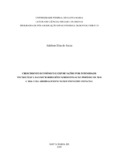Mostrar el registro sencillo del ítem
Crescimento econômico e exportações por intensidade tecnológica das microrregiões nordestinas no período de 2010 a 2016: uma abordagem em dados em painel espacial
| dc.creator | Souza, Adeilson Elias de | |
| dc.date.accessioned | 2021-08-09T21:27:31Z | |
| dc.date.available | 2021-08-09T21:27:31Z | |
| dc.date.issued | 2020-03-13 | |
| dc.identifier.uri | http://repositorio.ufsm.br/handle/1/21854 | |
| dc.description.abstract | The objective of the research is to evaluate the spatial relationship between exports, disaggregated by level of technological intensity, and the economic growth of the Northeastern micro-regions in the period from 2010 to 2016. To this end, an exploratory analysis of spatial data (AEDE) was applied, on exports and economic growth, investigating the possibility of global spatial autocorrelation, with an index for the entire Northeast, and local, with the spatial relationship between the micro-regions of northeastern and its neighbors, individually, through the maps of clusters. In addition, the economic growth model proposed by Cuaresma and Wörz (2005) was estimated, using the spatial panel data econometric method with fixed effects. The results showed that exports from the Northeast are concentrated in products of low technological intensity, which have low productivity and added value. In spite of this, the estimated model of the research points out that these exports contribute to the reduction of the economic growth of the microregions of the Northeast, as they have lower productivity than the domestic sector, as argued by Cuaresma and Wörz (2005). In addition to exports, it was found that the northeastern microregions need investments in the infrastructure and R&D sectors, in order to develop economically. In this way, policies that attract and stimulate investments in these areas can be adopted, such as the improvement of ports and highways and the expansion of research and development expenses. In addition, low competition between local companies and relatively closed markets discourages companies from generating technology costs in their production processes, since they have less competition in the market. Thus, the economic growth of the microregions of the Northeast is also stimulated by the commercial opening, generating the need for local companies to produce goods with greater technological content. | eng |
| dc.description.sponsorship | Coordenação de Aperfeiçoamento de Pessoal de Nível Superior - CAPES | por |
| dc.language | por | por |
| dc.publisher | Universidade Federal de Santa Maria | por |
| dc.rights | Attribution-NonCommercial-NoDerivatives 4.0 International | * |
| dc.rights.uri | http://creativecommons.org/licenses/by-nc-nd/4.0/ | * |
| dc.subject | Crescimento econômico | por |
| dc.subject | Exportações | por |
| dc.subject | Microrregiões do Nordeste | por |
| dc.subject | Economic growth | eng |
| dc.subject | Exports | eng |
| dc.subject | Microregions of the Northeast | eng |
| dc.title | Crescimento econômico e exportações por intensidade tecnológica das microrregiões nordestinas no período de 2010 a 2016: uma abordagem em dados em painel espacial | por |
| dc.title.alternative | Economic growth and exports by technological intensity of northeast micro-regions in the period 2010 to 2016: a space panel data approach | eng |
| dc.type | Dissertação | por |
| dc.description.resumo | O objetivo da pesquisa é avaliar a relação espacial entre as exportações, desagregadas por nível de intensidade tecnológica, e o crescimento econômico das microrregiões nordestinas no período de 2010 a 2016. Para tanto, foi aplicada a análise exploratória dos dados espaciais (AEDE), sobre as exportações e o crescimento econômico, investigando a possibilidade de autocorrelação espacial global, com um índice referente a todo o Nordeste, e local, com a relação espacial entre as microrregiões nordestinas e suas vizinhas, individualmente, por meio dos mapas de clusters. Além disso, foi estimado o modelo de crescimento econômico proposto por Cuaresma e Wörz (2005), utilizando o método econométrico de dados em painel espacial com efeitos fixos. Os resultados apontaram, que as exportações do Nordeste estão concentradas em produtos com baixa intensidade tecnológica, que possuem pequena produtividade e valor agregado. Apesar disso, o modelo estimado da pesquisa aponta que essas exportações contribuem para redução do crescimento econômico das microrregiões do Nordeste, ao possuírem produtividade inferior que a do setor doméstico, como argumenta Cuaresma e Wörz (2005). Além das exportações, constatou-se que as microrregiões Nordestinas necessitam de investimentos nos setores de infraestrutura e P&D, para se desenvolver economicamente. Dessa forma, políticas que atraiam e estimulem investimentos nestas áreas podem ser adotadas, como o melhoramento de portos e rodovias, e ampliação dos gastos em pesquisas e desenvolvimento. Além disso, a baixa competição entre as firmas locais e os mercados relativamente fechados, desencorajam as empresas a gerarem dispêndios em tecnologia nos processos de produção, por possuírem menor concorrência no mercado. Assim, o crescimento econômico das microrregiões do Nordeste, é estimulado também pela abertura comercial, gerando a necessidade de as empresas locais produzirem bens com maior conteúdo tecnológico. | por |
| dc.contributor.advisor1 | Feistel, Paulo Ricardo | |
| dc.contributor.advisor1Lattes | http://lattes.cnpq.br/9828248768218577 | por |
| dc.contributor.advisor-co1 | Silva, Magno Vamberto Batista da | |
| dc.contributor.referee1 | Pereira , Adriano José | |
| dc.contributor.referee2 | Anése, Rogério Luis Reolon | |
| dc.creator.Lattes | http://lattes.cnpq.br/3001441404799839 | por |
| dc.publisher.country | Brasil | por |
| dc.publisher.department | Economia | por |
| dc.publisher.initials | UFSM | por |
| dc.publisher.program | Programa de Pós-Graduação em Economia e Desenvolvimento | por |
| dc.subject.cnpq | CNPQ::CIENCIAS SOCIAIS APLICADAS::ECONOMIA | por |
| dc.publisher.unidade | Centro de Ciências Sociais e Humanas | por |
Ficheros en el ítem
Este ítem aparece en la(s) siguiente(s) colección(ones)
-
Programa de Pós-Graduação em Economia e Desenvolvimento [99]
Coleção de dissertações do Programa de Pós-Graduação em Economia e Desenvolvimento



